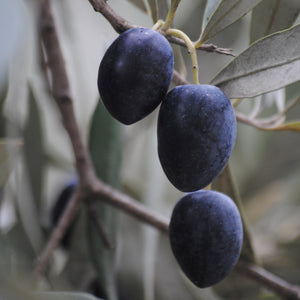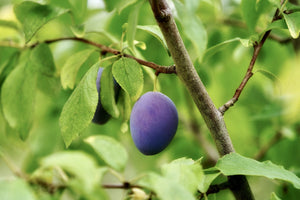The Plum Tree Guide
Plum trees, belonging to the Prunus genus, offer a captivating and timeless presence in any landscape. With their graceful stature, beautiful blossoms, and bountiful fruit, plum trees draw attention and infuse a touch of elegance into gardens and outdoor spaces. These wonderful trees are renowned for their adaptability and can thrive in diverse conditions when provided with the right care and attention. Whether you're looking to create a charming orchard retreat or desire a standout feature in your garden, plum trees make an excellent choice, combining both aesthetic appeal and a rewarding harvest.

About
Plum trees, members of the Prunus genus, encompass various deciduous trees admired for their striking presence and ecological importance. With numerous recognized species, plum trees are found in temperate regions across the globe, spanning North America, Europe, Asia, and more. These magnificent trees are characterized by their distinctive features and their vital role in supporting local ecosystems.
One of the remarkable features of plum trees is their smooth bark, often displaying an eye-catching contrast against their leaves. Plum tree leaves are typically ovate with serrated edges and showcase vibrant shades of green during the growing season. As the autumn season approaches, plum trees undergo a splendid transformation, unveiling a rich array of warm colors, including hues of yellow, orange, and copper.
Plum trees hold ecological significance by providing food and shelter for a wide range of wildlife. Their blossoms, forming in small clusters, serve as an early pollen source for bees and other beneficial insects. The plum's fruit, enclosed within fleshy skin, is a valuable food source for various birds and mammals.
These versatile trees can adapt to various soil types and environmental conditions. While they thrive in well-drained soil, plum trees can flourish in both full sun and partial shade. Their resilience against different climatic conditions and moderate growth rate make them an excellent choice for a variety of landscaping projects.
Whether employed as a captivating focal point in a garden, planted in clusters to create an orchard, or incorporated into mixed borders, plum trees introduce an aura of elegance and beauty to any landscape. Notable species of plum trees include the European plum (Prunus domestica) and the American plum (Prunus americana), both celebrated for their charming appearance and significant contributions to local ecosystems. By selecting and caring for plum trees within your landscape, you not only enhance the aesthetic appeal of your outdoor space but also contribute to the preservation of these magnificent trees and the biodiversity they support.

Planting
Plum trees come with specific planting and care requirements to ensure their successful establishment and growth. Here are some general guidelines for planting and caring for plum trees:
Soil: Plum trees thrive in well-draining soil that's rich in organic matter. They prefer slightly acidic soil with a pH range between 6.0 and 7.0. Before planting, prepare the site by loosening the soil and incorporating compost or organic matter to enhance both drainage and fertility.
Sunlight: Plum trees prefer full sun, although they can tolerate partial shade. Opt for a location that receives a minimum of six hours of direct sunlight daily. In areas with hot and dry climates, they can also tolerate some shade.
Watering: Adequate and timely watering is crucial for the initial establishment of plum trees. Right after planting, give the tree a deep watering, and continue providing regular irrigation throughout the first year. Water deeply and thoroughly once or twice a week, depending on local rainfall and soil moisture levels. Be cautious not to overwater, as excessive moisture can lead to root rot.
Mulching: Apply a layer of organic mulch around the base of your plum tree to conserve moisture, suppress weed growth, and regulate soil temperature. Suitable mulch materials include wood chips, bark, or compost. Ensure the mulch is kept a few inches away from the tree trunk to prevent excess moisture buildup.
Pruning: Plum trees generally require minimal pruning. Focus on removing any dead, damaged, or crossing branches to maintain a strong and balanced tree structure. Pruning should be done during late winter or early spring while the tree is dormant, ideally before new growth begins.
By following these fundamental planting and care instructions, you can ensure that your plum trees establish themselves successfully, ensuring their healthy growth and fruit production, and enhancing the beauty of your landscape for years to come.

Care
Plum trees, just like any other fruit tree, have specific care requirements to ensure their optimal growth and bountiful harvest. Here are some general guidelines for caring for plum trees:
Watering: Plum trees require consistent watering during the growing season. Aim to provide about one inch of water per week, adjusting as needed based on local rainfall. It's crucial to water deeply and thoroughly to encourage deep root growth. Shallow watering should be avoided, as it can lead to stress and dehydration in the tree. In periods of drought or high temperatures, you may need to increase your watering frequency to maintain adequate soil moisture.
Pruning: Pruning plum trees is essential to maintain their overall health and structure. While plum trees do not require extensive pruning, it's advisable to remove any dead, damaged, or diseased branches. Additionally, you can shape the tree to achieve your desired size and form. Pruning should be carried out during late winter or early spring before new growth emerges. Be sure to use clean, sharp pruning tools to minimize the risk of injuring the tree. Deadheading spent flowers can also stimulate new growth and potentially lead to a second round of fruiting.
Fertilizing: Fertilizing plum trees is crucial for healthy growth and fruit production. Apply a balanced, slow-release fertilizer in the spring or early summer, following the recommended application rates and timing provided by the manufacturer. It's important to avoid over-fertilizing, as this can damage the tree's roots. When in doubt, it's safer to use less fertilizer rather than excess.
Soil and Sunlight: Plum trees prefer well-drained soil that's consistently moist. They thrive in full sun exposure, but they can tolerate some partial shade. Although plum trees are relatively adaptable to different soil types, it's vital to ensure well-draining soil for optimal growth. Additionally, mulching around the base of the tree can help retain moisture and regulate soil temperature.
Pests and Diseases: While plum trees are generally resilient, it's essential to remain vigilant for common issues like aphids, plum curculios, and diseases like brown rot. If you observe any signs of damage or disease, take prompt action and treat the tree with appropriate insecticides or fungicides to prevent the issue from spreading.
By following these fundamental care guidelines, your plum trees will thrive, providing a bountiful harvest and adding natural beauty to your garden for years to come.

How To Use
Plum trees, with their enticing fruit and vibrant foliage, can be a valuable addition to your landscape. Here are some versatile ways to incorporate plum trees into your outdoor environment:
Fruit Orchard: Create your own mini orchard by planting multiple plum trees. This approach not only provides an abundant harvest of plums but also adds a charming, rustic feel to your landscape. Arrange the trees in rows or groups for an appealing orchard layout.
Privacy Screen: Plum trees can be used to establish an attractive and functional privacy screen. Plant them in a row along property lines or near patios to create a natural barrier. The dense foliage provides privacy while the spring blossoms and fruiting add visual interest.
Edible Landscape: Plum trees are a delightful addition to any edible landscape. Intermingle them with other fruit trees, shrubs, and ornamental plants to create a beautiful, productive space. The mix of colors from various fruiting plants enhances the aesthetics of your garden.
Shade and Seating Area: Strategically plant plum trees to provide shade to your outdoor seating areas, such as patios, decks, or picnic spots. The dappled sunlight filtering through their foliage creates a pleasant environment for relaxation and outdoor dining.
Focal Point: Use a single plum tree as a stunning focal point in your garden. Its blossoms in spring and fruit in summer make it an eye-catching centerpiece. Add some decorative elements like a bench or a garden statue to complete the look.
Mixed Border: Incorporate plum trees into mixed borders or flower beds. Their seasonal interest, from blossoms to fruit, adds variety and charm to your garden. You can interplant them with ornamental shrubs and flowers for a striking effect.
Wildlife Habitat: Like other fruit trees, plum trees can attract wildlife. The flowers and fruit provide a food source for pollinators, and the ripe plums are a favorite among birds. Use plum trees to create a welcoming habitat for a variety of wildlife in your garden.
Container Gardening: If you have limited space, consider growing plum trees in large containers. This allows you to enjoy fresh plums on a patio or balcony. Choose dwarf or semi-dwarf varieties suitable for container gardening.
Remember to consider the specific plum tree variety and its growth habits when planning its placement in your landscape. Whether you're aiming to create an edible garden, add privacy, or simply enjoy the beauty of plum blossoms and fruit, these trees can be a versatile and functional addition to your outdoor space.
Conclusion
Plum trees are a delightful and versatile addition to any orchard or garden. Their abundant fruits, unique foliage, and value in supporting local ecosystems make them a sought-after choice for various settings. By following proper planting and care practices, you can experience the delicious fruit and ornamental beauty of plum trees in various ways, whether it's cultivating a productive orchard or adding a charming element to your landscape. Whether you opt for maximizing fruit production or enhancing your garden's aesthetics, plum trees offer a multitude of possibilities for your outdoor space. With dedication and care, you can cultivate a fruitful garden that brings you joy and delectable plums for years to come.retreat in your backyard. Whether you choose to showcase their elegance as a focal point or incorporate them into a larger design, beech trees offer endless possibilities to enhance the allure of your outdoor space. With dedication and care, you can create a breathtaking landscape that will bring you lasting joy for years to come.


